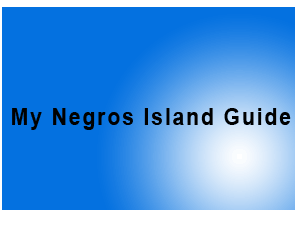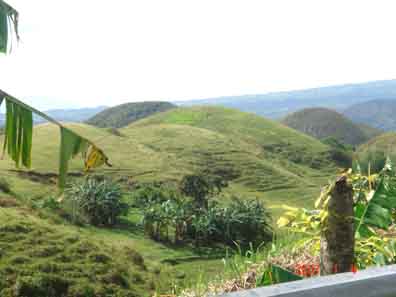- GENERAL INFORMATION
- General Info
- Money
- CITIES/TOWN
- Bacolod City
- Bago City
- Cadiz City
- Escalante City
- Himamaylan City
- Kabankalan City
- La Carlota City
- Sagay City
- San Carlos City
- Silay City
- Sipalay City
- Talisay City
- Victorias City
- Binalbagan
- Calatrava
- Candoni
- Cauayan
- EB Magalona
- Hinigaran
- Hinoba-an
- Ilog
- Isabela
- La Castellana
- Manapla
- Moises Padilla
- Murcia
- Pontevedra
- Pulupandan
- Salvador Benedicto
- San Enrique
- Toboso
- Valladolid

The Ruins
Like a lady wooed by her man, the Ruins play with your emotions especially at sunset with its orange pinks and purples hues. He charms, tickles and romances you. But at sundown, the Ruins take a different persona. With blue and golden sights emanating from nooks and crannies, it is now a lady, teasing, flirting, a temptress confident of her beauty as well as her majesty.

Bacolod …. Fun in the Mountain
Motor to the Hawaiian Philippines Company for some orientation on how the famous muscovado sugar is made. Here, you will have a good understanding of the island’s sugar industry and how it is able to sweeten your day.
San Carlos City
San Carlos City is a 2nd class component city in the province of Negros
Occidental, Philippines. The settlement was elevated to city status on July 1,
1960 per Republic Act 2643. According to the August 1, 2007 census, it has a
population of 129,809 people. Located along the coast of Tañon Strait, the city
is located at the crossroads of four major cities in the Visayas: Cebu City,
Bacolod City, Iloilo City and Dumaguete City.
It has a long coastline that runs to 40 kilometers which is protected by the
city's mangrove reforestation program while its seas are closely guarded from
abuse by this active Bantay Dagat force. Nature has also endowed with a deep
natural harbor that can take in large shipping vessels.
This harbor is also protected from inclement weather by Refugio Island. Due to
these special attributes, the Philippine Ports Authority has chosen the San
Carlos City port from among other ports in the province for its expansion
program in 1998 which include the reclamation of four hectares of sea to
accommodate various port buildings, facilities and container vans, an extension
on the east side for two RO-RO vessels and the extension of the length of the
port to 242.5 meters.
Festivals
The Pintaflores Festival was born out of the city's search for a cultural
identity and tradition. With Cebu City having its Sinulog, Bacolod City its
MassKara Festival, and Aklan its Ati-atihan, San Carlos City also dreamed of
having its own unique festival.
In 1992, after successfully holding two activities, the Nabingkalan Tattoo
Festival and the Dances of Flowers as highlights of the city fiesta, the idea of
blending the two concepts to come up with a presentation that could be
considered the city's very own started what today is one of the most popular
street dancing festivals in the region, the Pintaflores Festival.
Pintaflores is coined from the words pintados ("painted ones"), the concept
behind the Nabingkalan Tattoo Festival, and flores, the Spanish word for
"flowers" that dominated the theme of the Dances of Flowers. The Pintaflores
street dancing and ritual competition highlights the annual Pintaflores Festival
every November 3-5.
It features rhythmic dances and dance dramas of life and death and the triumph
of good against evil that depict the people's thanksgiving and merriment,
abundant blessings and success. As part of the Pintados tradition, the faces,
arms, bodies and legs of the dancers are painted with flowers to express
gratitude to man and his environment.
The street dancing is culminated by a dance ritual performed at the City
auditorium. Different dance steps and musical accompaniment add to the thrill of
the competition. The human flower formation is another impressive part of the
dance ritual which are products of the ingenuity and skill of the choreographers
and dancers.


